Trained Master Naturalists Indispensable to Conservation Studies
By Paula Levihn-Coon
Reporting Texas
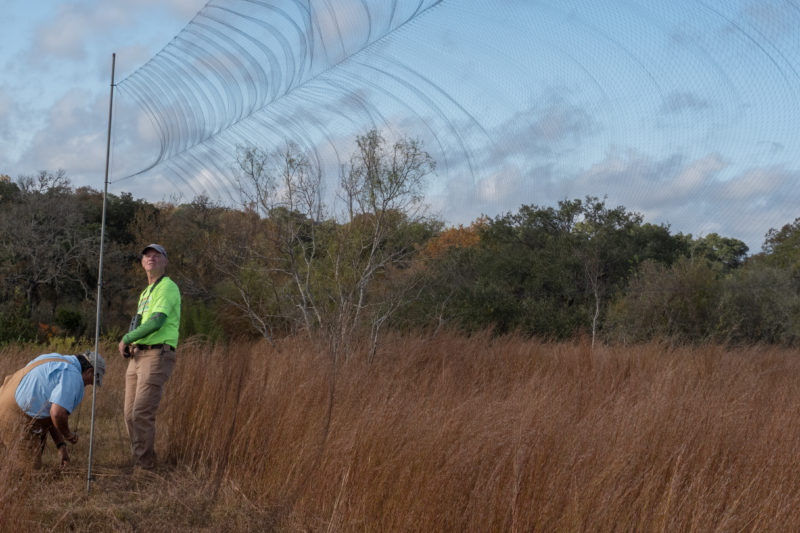
Ken Butler, right, checks the mist net he and Craig Hensley installed at Cibolo Nature Center in Boerne, Texas, on Nov. 17, 2021. Butler, a Texas Master Naturalist and volunteer, was helping Hensley, a biologist with Texas Parks and Wildlife Department, catch and band birds for a study. Paula Levihn-Coon/Reporting Texas
BOERNE – At the crack of dawn on a perfectly clear Wednesday morning in November, Craig Hensley, a Texas Parks and Wildlife biologist, was joined by seven committed, well-trained volunteers at Cibolo Nature Center in Boerne.
The volunteers, all certified Texas Master Naturalists, came to the preserve to help Hensley flush sparrows into nets so he can measure and weigh them for a study he is conducting.
One for the volunteers, Jill Boyter, recorded the data, which will be sent to the Federal Bird Banding Laboratory. Boyter became a Texas Master Naturalist eight years ago because, as president of her homeowners’ association, she wanted to educate fellow homeowners about ecologically sustainable land management practices, she said.
“The type of person that’s involved is someone who’s continuously interested, always wanting to be a part of the world, community, and then use the skills they have,” Boyter said. “Everyone comes with some enormous talent. This is able to lift up research and science in the world.”
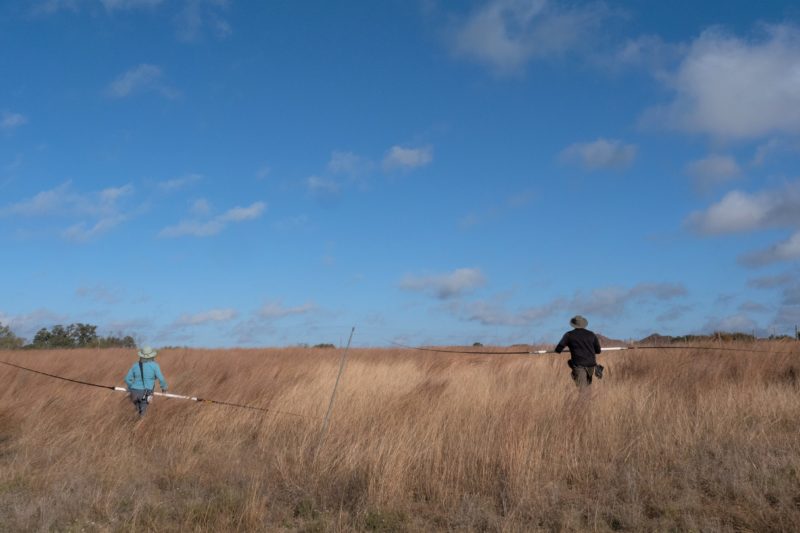
Texas Master Naturalists Jenni Sorenson, left, and Derrick Mims flush bird into nets at Cibolo Nature Center so they can be banded for a four-year conservation study by Texas Parks and Wildlife Department. The study will ascertain how suburban fields like this one are used by grasshopper and LeConte’s sparrows. Paula Levihn-Coon/Reporting Texas.
The naturalists are indispensable to Hensley’s study. “If I didn’t have their help, there’s no way to do this kind of research,” Hensley said. “I can’t go through a field like this with 10 of those poles (and flush out birds) by myself. This is, literally, a group operation.”
Founded in 1998, the Texas Master Naturalist Program is jointly sponsored by Texas Parks and Wildlife Department and Texas A&M AgriLife Extension Service.
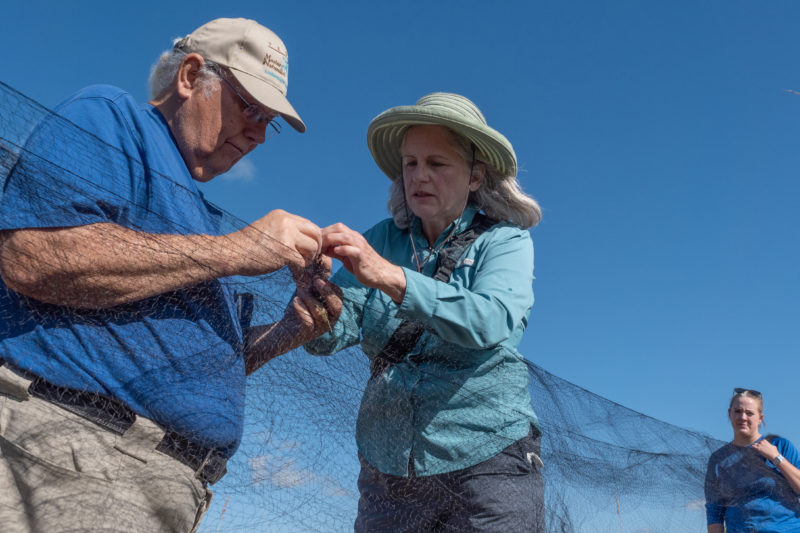
Stephen Veuschooyl, from left, and Jenni Sorenson remove debris from a mist net as Christy Reed watches at Cibolo Nature Center. They are among 15,000 trained Texas Master Naturalists who have contributed more than 5.5 million service hours to the program. Paula Levihn-Coon/Reporting Texas
“There are about 6,000 active TMNs this year and we have trained over 15,000 to date with the program,” said Mary Pearl Meuth, the program’s assistant state coordinator. “Volunteers have contributed more than 5.5 million volunteer service hours valued at more than $121 million.”
Certification as a Master Naturalist is earned through 40 hours of training and 40 hours of volunteer work in the first year. The training can cost up to $200. To stay certified, naturalists must volunteer at least 40 hours a year and undergo eight hours of advanced training annually.
The Texas program was the first of its kind in the United States. There are now similar programs in almost all other states.
Most of the volunteers are retired. Boyter ran a nonprofit. One was a veterinarian. Another worked in the oil and gas industry.
“People have come as second careers and work as vigorously and as talented as they did in their first very successful lives,” Boyter said. “They bring so much to the research.”
Of the volunteers at Cibolo Nature Center in November, only Christy Reed was not retirement-aged. The 30-year-old is a Texas State University graduate with a degree in early childhood education. She works as a nanny.
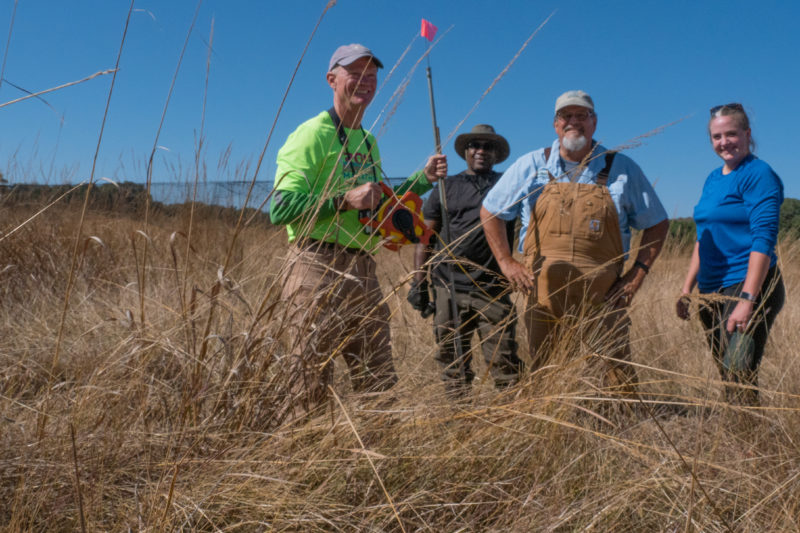
Although most volunteers are retirement age, Christy Reed, right, a 30-year-old Texas State graduate, forms part of the naturalist team along with Ken Butler, from left, Derrick Mims and Craig Hensley. Paula Levihn-Coon/Reporting Texas
Reed aims to be an environmental scientist one day. In January, she will start school at the University of Texas at San Antonio to earn a degree in Environmental Science with a concentration in Natural Resources and Wildlife Management, she said.
The reasons the volunteers became Texas Master Naturalists vary.
For most, it’s not about the hours and enameled pins that are earned each year. It’s about the experience, the education, and the feeling of doing something worthwhile.
Bob Binney is a seasoned volunteer, with almost 5,200 volunteer hours under his belt – about two and a half years of full-time work. He learned to love sharing nature with the public when he owned a dolphin watch boat in Corpus Christi.
Derrick Mims was a birder and photographer before he became a Master Naturalist.
“I liked nature. My grandfather worked at a nature center,” said Mims, who retired recently from his job in the army as an aviation mechanic supervisor. “I’m a photographer turned naturalist. I’ve participated in bird and butterfly counts. I’ve been in aviation my whole career, so you could say I like things with wings.”
Ken Butler has participated in bird, butterfly and dragonfly surveys, including a butterfly survey at Guadalupe State Park that Hensley manages. Butler’s love of photography complements his naturalist work. “Photography was a natural marriage to being a naturalist because it helped both document and record, and learn,” he said.
Several of the volunteers work together regularly at other wildlife areas, including Old Tunnel State Park in Fredericksburg, where they educate the public about bats; the YMCA Roberts Ranch in Comfort, where they participate in educational programs, fundraising and coordinating other volunteers; and the Butterfly Learning Center at the Phil Hardberger Park in San Antonio, where they maintain the gardens.
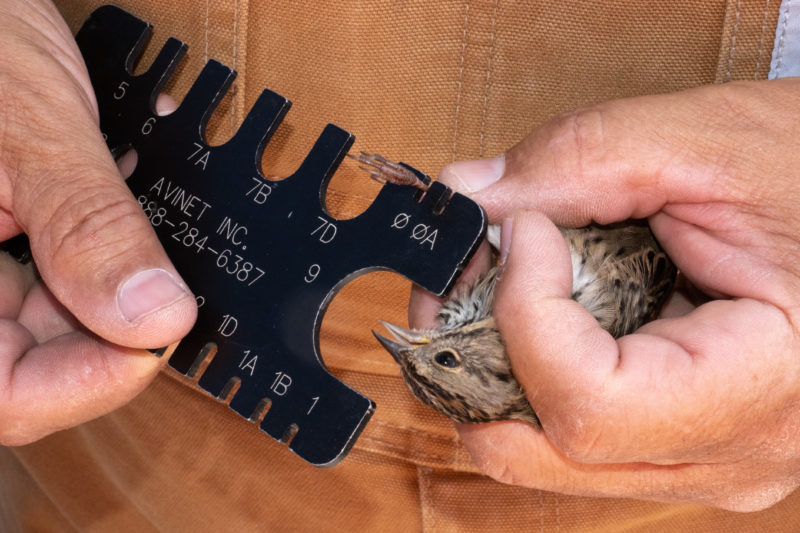
Craig Hensley, a biologist with Texas Parks and Wildlife Department, puts a Lincoln’s sparrow’s leg into a gauge to determine what size band the bird needs at Cibolo Nature Center. Although the conservation study Hensley leads is specifically studying LeConte’s and grasshopper sparrows, all birds that are netted are banded. Paula Levihn-Coon/Reporting Texas
“I worry about it a lot. I want (the volunteers) to get something out of it that is meaningful to them, besides hours,” Hensley said. “Giving people the opportunity to learn is really pretty valuable.”
Hensley wears many hats when leading a project. He is an ornithologist, educator, equipment wrangler, people leader, inspiration provider, data collector, and entertainer, all rolled into one.
And he is grateful for the help his volunteers give him.
“Here in Texas, we are really quite blessed to have a Master Naturalist program because it builds up this core – a powerful entity of people that can contribute to conservation efforts, big and small,” Hensley said. “And that’s what they do.”
To become a certified Texas Master Naturalist, visit https://txmn.tamu.edu.